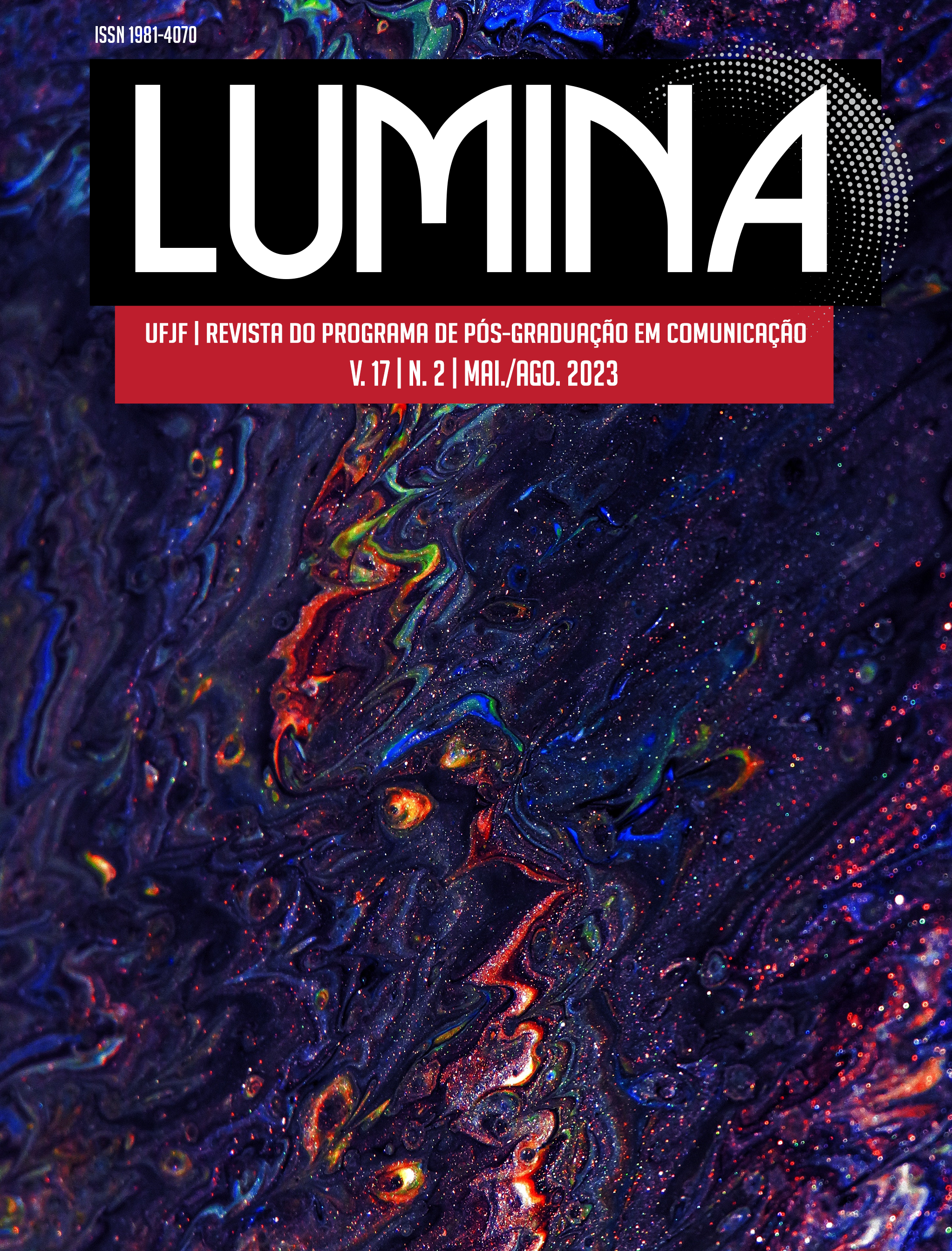Linguagem memética e memória afetiva: análise das estratégias editoriais na divulgação do retorno das telenovelas antigas na plataforma de streaming Globoplay
DOI:
https://doi.org/10.34019/1981-4070.2023.v17.39761Keywords:
Cultura da convergência, Memes, Memória, Globoplay, TelenovelasAbstract
Since its launch in 2015, Globoplay, Grupo Globo’s streaming service, has expanded its participation in the Brazilian audiovisual segment. Among the many strategies adopted by the platform, the use of old telenovelas from TV Globo is understood as part of its strategy. This study aims to analyze the communication strategies adopted on Instagram by Globoplay with the goal of publicizing or returning two old titles to the platform. We assume that, as an attempt to retain the attention of the young public for the consumption of old telenovelas, memes are used within the editorial strategies of the platform as a way of engagement. In this sense, we collected 2,577 posts on the official profile of the platform on Instagram and, based on the data processing techniques of the Content Analysis (BARDIN, 1977), 205 publications linked to the project of the old telenovelas were subcategorized. The study evidences the strength of memes and indicates the use of memetic language to “revitalize” these audiovisual contents and make them more engaging in the context of this participatory culture.
Downloads
References
APPADURAI, A. Modernity at Large: Cultural Dimensions of Globalization. Minneapolis: University of Minessota Press, 1996.
BARDIN, L. Análise de Conteúdo. São Paulo: Edições 70, 1977.
BRESSAN JÚNIOR, M. A. Memória Teleafetiva. Florianópolis: Insular, 2019.
BRÊTAS, E. XV Seminário Internacional Obitel. ECA/USP, 19. nov. 2020, vídeo no YouTube. Disponível em: <https://youtu.be/DEH85umdzY4>. Acesso em: 19 mai. 2021.
DAWKINS, R. The Selfish Gene. Nova York: Oxford University Press, 1976.
GOULART RIBEIRO, A. P. Mercado da nostalgia e narrativas audiovisuais. E-Compós, v. 21, n. 3, p. 1-15, 2018. DOI: <https://doi.org/10.30962/ec.1491>.
HOLDSWORTH, A. Television, memory and nostalgia. Basingstoke: Palgrave Macmilan, 2011.
HUYSSEN, A. Seduzidos pela memória: arquitetura, monumentos, mídia. Rio de Janeiro: Aeroplano Editora, 2000.
JACKS, N. et al. Telenovela e memória: “Vale a pena ver de novo?”, reprises em tempo de pandemia. RuMoRes, v. 14, n. 28, p. 46-76, 2020. DOI: <https://doi.org/10.11606/issn.1982-677X.rum.2020.174427>.
JENKINS, H. Cultura da convergência. Rio de Janeiro: Aleph, 2009.
JENKINS, H.; GREEN, J.; FORD, S. Cultura da conexão: criando valor e significado por meio da mídia propagável. Rio de Janeiro: Aleph, 2014.
LE BRETON, D. As paixões ordinárias: antropologia das emoções. Petrópolis: Vozes, 2009.
LEMOS, L. P.; ROCHA, L. L. F. Ficção televisiva brasileira e covid-19: reconfigurações e estratégias de programação. Lumina, v. 16, n. 1, p. 45–60, 2022. DOI: <https://doi.org/10.34019/1981-4070.2022.v16.33616>.
LÉVI-STRAUSS, C. Il pensiero selvaggio. Milão: Il Saggiatore, 1964.
MARINO, G. Semiótica da propagabilidade: uma abordagem sistemática de memes e virais de Internet. Revista Ícone, v. 16, n. 1, p. 9-41, 2018. DOI: <https://doi.org/10.34176/icone.v16i1.237495>.
POLLAK, M. Memória e Identidade Social. Estudos Históricos. Rio de Janeiro, v. 5, n. 10, p. 200-212, 1992. Disponível em: <https://bit.ly/3OF6rs3>. Acesso em: 13 jun. 2023.
RAMOS, E.; BORGES, G. As janelas do Grupo Globo e o resgate de um formato com valor de culto no streaming Globoplay. Revista Graphos, v. 23, n. 2, p. 11–28, 2021. Disponível em: <https://bit.ly/3QmkdRh>. Acesso em: 01 dez. 2022.
NOTÍCIAS DA TV. Reprise de Fina Estampa supera maior fracasso de Aguinaldo Silva na Globo. Notícias da TV, [S.l], On-line, 21 set. 2020. Disponível em: <https://bit.ly/3QDPShB>. Acesso em: 29 mar.
RUSHKOFF, D. Media Virus!: Hidden Agendas in Popular Culture. Nova York: Ballantine Books, 1994.
SANCHEZ, L. Em meio a pandemia, Globo suspende gravações e levará reprises ao horário nobre. Folha de São Paulo, On-line, 16 mar. 2020. Disponível em: <https://bit.ly/44NGEDj>. Acesso em: 29 mar. 2022.
SHIFMAN, L. Memes in a Digital World: Reconciling with a Conceptual Troublemaker. v. 18, n. 3, p. 362–377, 2013. DOI: <https://doi.org/10.1111/jcc4.12013>
SPAZIANTE, L. Sociosemiotica del pop. Identità, testi e pratiche musicali. Roma: Carocci, 2007.
SANTOS NETO; V. S.; BRESSAN JÚNIOR, M. A. As complexas relações arquivísticas, mercadológicas e afetivas diante das práticas de preservação e compartilhamento do arquivo televisivo do Grupo Globo: o caso da plataforma Globoplay. Rebeca, v. 11, n. 2, p. 1-25, 2022. DOI: <https://doi.org/10.22475/rebeca.v11n2.828>.
SANTOS NETO; V. S.; LESSA, L. A.; BRESSAN JÚNIOR, M. A. Pensar a memória e a função do arquivo televisivo na era do streaming: um olhar para a plataforma Globoplay. Estudos Históricos, v. 36, n. 78, p. 182–200, 2023. Disponível em: <https://bit.ly/3rPd6GV>. Acesso em: 15 jun. 2023.
Published
How to Cite
Issue
Section
License
Autores que publicam nesta revista concordam com os seguintes termos:
- Autores mantém os direitos autorais e concedem à revista o direito de primeira publicação, com o trabalho simultaneamente licenciado sob a Licença Creative Commons Attribution que permite o compartilhamento do trabalho com reconhecimento da autoria e publicação inicial nesta revista.
- Autores têm autorização para assumir contratos adicionais separadamente, para distribuição não-exclusiva da versão do trabalho publicada nesta revista (ex.: publicar em repositório institucional ou como capítulo de livro), com reconhecimento de autoria e publicação inicial nesta revista.
- Autores têm permissão e são estimulados a publicar e distribuir seu trabalho online (ex.: em repositórios institucionais ou na sua página pessoal) a qualquer ponto antes ou durante o processo editorial, já que isso pode gerar alterações produtivas, bem como aumentar o impacto e a citação do trabalho publicado (Veja O Efeito do Acesso Livre).








